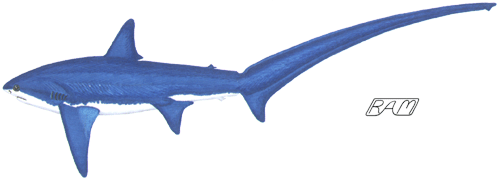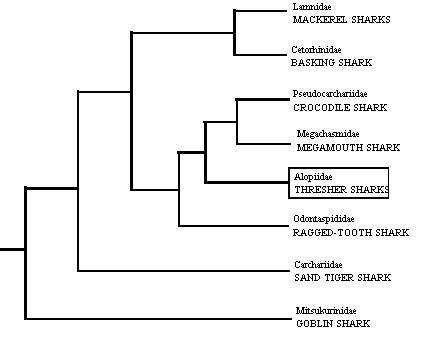Family Alopiidae:
Thresher Sharks — 3 species
- upper lobe of caudal fin long and curving, about as long as the shark's body (the family name means "fox", another creature renowned for its resplendent tail)
- head short, snout moderately long and conical
- mouth small, teeth small to moderately large
- gill slits short, the last two above the pectoral fin base
- pectoral fins long and narrow
- eyes large (those of Alopias superciliosus are proportionately the largest of any non-avian vertebrate)
- second dorsal and anal fins small, both with pivoting bases
- precaudal pits present; tail stalk thick without lateral keels
- circulatory system modified, allowing retention of metabolic heat
- scattered distribution in coastal and oceanic waters; cool temperate to tropical zones of Atlantic, Pacific, and Indian oceans.

Common Thresher Shark (Alopias vulpinus)
The whip-tailed threshers are among the most easily recognizable of sharks. Despite their lack of obvious mackerel shark characteristics (such as equal-lobed tail, narrow tail stalk supported by strong lateral keels, large gill slits and jaws), thresher sharks have traditionally been regarded as closely allied with the great white and other mackerel sharks of the family Lamnidae. However, the recent (1997) comparative mtDNA study of lamnoids by Naylor et al. suggests that the threshers share a closer common ancestor with the ragged-tooth sharks (Odontaspididae) and a second group composed of the megamouth (Megachasmidae) and crocodile sharks (Pseudocarchariidae).
Given their many shared specialized characters, it is rather surprising that Naylor et al's molecular genetics data did not provide strong support for monophyly (all derived from a common ancestor) of the thresher sharks. In some cladograms representing the genetic data, the Bumpytail Ragged-Tooth Shark (Odontaspis ferox) actually appeared within the Alopiidae; in others, the Megamouth Shark (Megachasma pelagios) appeared within this group. These unprecedented results suggest that all these sharks are genetically very similar, having changed relatively little since they diverged from the common ancestor of their meta-group. Compagno recently (1990) proposed a close affinity between the Megamouth Shark and the threshers; this is intuitively appealing, as the structure of the second dorsal fin, anal fin, and tail of both groups (Megachasmidae and Alopiidae) is strikingly similar. The interpretation followed here (depicted in the cladogram above) is that, 1) the odontaspidids form a primitive sister taxon to the meta-group consisting of the alopiid, megachasmid, and psudocarchariid sharks, and 2) the alopiids branch off next, forming a primitive sister taxon to the megachasmid and pseudocarchariid sharks.
The alopiids apparently diverged fairly recently. The thresher shark lineage first appears in the fossil record some 55 million years ago, represented by the fossilized teeth of Alopias crochardi. At least two species of thresher shark, the Common Thresher (Alopias vulpinus) and the Bigeye Thresher (Alopias superciliosus), have portions of their circulatory system modified into a counter-current heat exchanger, which allows them to retain metabolic heat. An homologous (structurally similar) — though more extensively developed — system also occurs in the mackerel sharks. Thus, warm-bodiedness appears to have evolved independently in two separate lineages of lamnoid (the families Alopiidae and Lamnidae).
A recent (1995) study by Blaise J. Eitner using electrophoretic analysis of serum proteins from all three recognized species of alopiid from several populations suggests a new, as-yet unrecognized species of thresher shark from the Pacific coast of Mexico. The potential new species is most similar to the common thresher shark. Molecular genetics is revolutionizing our understanding of marine biodiversity, frequently revealing that what we thought was a single, widespread species may, in fact, be a series of "cryptic species" — outwardly very similar, but genetically as distinct from one another as visibly dissimilar species.
- More about the life history and behavior of the Pelagic Thresher
- More about the life history and behavior of the Bigeye Thresher
- More about the life history and behavior of the Common Thresher

